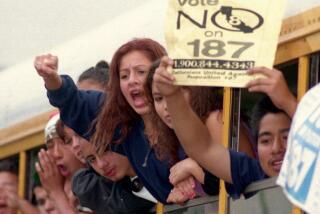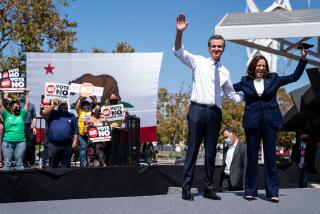NEWS ANALYSIS : Race Often Plays Real but Unspoken Role in Politics : Campaigns: Candidates shun overt appeals to prejudice, but social scientists say it underlies many issues.
- Share via
No one talks about it. But beneath a landscape dominated by crime, immigration and welfare reform, politics in California this year is riven by a silent fault line. Race.
None of the candidates overtly appeal to prejudice. Everyone denies even suggesting racial themes. But social scientists believe the undercurrent is implicitly there, looming large from the anti-illegal immigrant Proposition 187 to the emphasis on crime that has recently dominated the governor’s contest.
Whether the candidates intend to or not--and many political scientists firmly believe they do--they are playing on a field strewn with racial land mines when they engage in the abbreviated, slogan-heavy discussions of these issues that dominate political discourse, analysts say.
Racially implicit advertisements, including some that have marked California campaigns, can strike a nerve of prejudice even among well-meaning voters who pride themselves on an absence of bias, according to recent studies. That tendency is all the more pronounced under the conditions present in California, where an overwhelmingly white electorate finds itself increasingly convulsed by economic and social worries.
“When they say welfare, the white voter thinks of blacks, in spite of the fact that the majority of welfare recipients are white,” said Joe Feagin, a University of Florida sociologist who specializes in race and politics. “When white voters hear about crime in the streets, most think blacks and Latinos despite the fact that most crimes are done by whites.
“Politicians play off of that. . . . They make very good use of it.”
Not surprisingly, candidates deny any such intent.
“The premise is crap,” said Larry Thomas, a senior adviser to Gov. Pete Wilson’s reelection campaign. Wilson came under fire this year for a commercial that pictured immigrants massed at the California-Mexico border as an announcer intoned, “They keep coming.”
“The principal issues,” Thomas added, “are of concern to people of all races in this state. Whether it’s crime, illegal immigration, jobs--the fact is that our campaign has communicated about each subject to everyone regardless of their race or age or makeup.”
Kathleen Brown’s gubernatorial campaign has gone out of its way to be sensitive, senior aide Steven M. Glazer said.
Glazer said that when the campaign was seeking a case to symbolize its claim that the Wilson Administration has mismanaged the state’s parole system, it deliberately picked a white convict who had committed crimes while on parole. To do otherwise would have perpetuated a stereotype about minority criminals, he said.
Despite these denials, political scientists who have watched the campaigns for governor, U.S. Senate and various propositions in California this year say that the appeals in them are typical of a new, indirect way that race affects politics.
In most cases, ethnicity is not directly raised in advertising, which is the main tool of political communication in California.
But those who study the collision of politics and race relations say that when Wilson and Sen. Dianne Feinstein pledge to curb illegal immigration, or when Brown and Feinstein challenger Rep. Mike Huffington vow to cut welfare, voters can receive signals about the candidates’ perceived views on minorities.
Larry Bobo, a UCLA professor of sociology and director of the Center for Research on Race, Politics and Society, said that crime, immigration and welfare reform all “have a strong racial subtext.”
“In many ways the discussions that we might see on the news and in political speeches sound rational and dispassionate, based on information,” he said. “What underlies that is not so neutral and clean and antiseptic. There’s basically, unfortunately, a large element of . . . negative stereotyping that underlies the potency of some of these issues.”
Candidates argue that the issues are legitimately part of this year’s political campaigns because they are in the forefront of voters’ minds and they have financial repercussions for the battered California economy.
Social scientists acknowledge that candidates do have to discuss issues of importance to voters. And they agree that it is possible to be, say, against welfare without being racially biased. But they argue that many people express biases with their positions on the issues.
“People can oppose these policies without being racist,” said Frank Gilliam, associate professor of political science at UCLA. “The question is, how tight is the correlation between people’s underlying negative (beliefs about) groups and their opposition to policies. There’s some suspicion that the correlation is high.”
Even those who are critical of candidates for their treatment of racially sensitive issues acknowledge that the candidates and the voters are in something of a box on the subject. To discuss sensitive issues while simultaneously shooting down stereotypes would take a far deeper discussion of social problems than exists in most campaigns, they say.
“It’s difficult to have a nuanced discussion in a 30-second commercial,” said Melvin L. Oliver, director of the UCLA Center for the Study of Urban Poverty.
The countering arguments can be seen in the immigration issue. Wilson argues that illegal immigration is an important issue because cash-strapped California is footing a multibillion-dollar bill for such immigrants, a cost that he says should be borne by the federal government. The governor says that is the sole reason he has discussed it, and vehemently denies even indirectly raising issues of ethnicity.
Yet it also is true that it has been in Wilson’s political interest to rally the largely white electorate--83% white in the June primary--to his side. One way to do it, Bobo said, is to play on fears stirred by changing social conditions, such as the growing prominence of minorities in California.
“If one were to take the cynical view for the moment: Say you’ve got a moderate to conservative governor who’s found him- or herself in the first term raising taxes and forever infuriating the far right element to his or her constituency,” Bobo said, drawing an undeniable portrait of Wilson. “I don’t think you could have found a better issue than immigration to (solidify) a right-wing base and (touch) an issue that is making some in the middle of the road or Democrats increasingly uncomfortable.”
Racially implicit appeals are certainly not new to politics. Among the more celebrated in recent years was then-Vice President George Bush’s use of the Willie Horton case against Democrat Michael S. Dukakis in 1988. Horton, a convicted killer, was released from a Massachusetts prison on a furlough, during which he raped a woman and assaulted her husband. The Bush campaign used the case to underscore its contention that Dukakis, the state’s governor, was soft on crime--a view that Dukakis was never able to dispel.
“The way the Willie Horton ad worked was not because of explicit appeals,” said Michael Dawson, associate professor of political science at the University of Chicago. “It was that it appealed to stereotypes of black male rapists that have been around since the Civil War.”
Another infamous campaign advertisement was run by North Carolina Sen. Jesse Helms in his 1990 race against Harvey Gantt, a black former mayor of Charlotte. What became known as the “hands” ad featured a pair of white hands crumbling a job application while the announcer laments that the job went to a minority because of a “racial quota.”
Both ads had one intention, according to Dawson: “To mobilize white voters.”
Arguments like these have the veneer of discussing an issue rather than impugning a specific race. The distinction, Dawson says, could be seen in the extreme in the 1991 candidacy of David Duke, a former Ku Klux Klansman, for governor of Louisiana.
“David Duke became a viable candidate when he talked about welfare and crime, as opposed to when he was wearing the white sheet,” Dawson said. “It was the same David Duke, and a different way of characterizing the issue.”
Recent studies by Tali Mendelberg, a Princeton University political scientist, suggest that indirect racial appeals are more powerful that overt ones.
Mendelberg conducted two studies. In the first, she showed participants news footage that included part of the Willie Horton ad. She sought to determine whether the ad sent a message, as the Bush campaign contended, only about crime. Interviews with participants showed that it decidedly did not. Rather than hardening the participants’ views about crime, the ad played to racial resentments, Mendelberg said.
The participants “decided they really didn’t want more spending to aid blacks,” she said.
In the second study, Mendelberg created newscasts featuring make-believe candidates talking about welfare. Some of the white participants saw accompanying pictures of white welfare recipients; the others saw black recipients. The results seconded her earlier findings.
The studies also reinforced the widespread belief among scholars that indirect racial appeals work better than direct ones: When the “candidates” featured in the welfare study made a point of talking about black welfare recipients, the study participants realized that the intent was racial and the appeal “did not work the same way at all,” she said.
Mendelberg’s welfare study also suggested that voters are not necessarily aware that a racial appeal has worked on them. When she asked study participants whose racial concerns had been affected by the welfare footage whether they thought it was a racial appeal, “almost everyone said no.”
According to some political scientists, even the best-intentioned candidate can pluck a racial chord that runs deep within people.
“A lot of white voters are ambivalent about issues dealing with race,” Mendelberg said. “On the one hand, they are committed to some extent to the idea of racial equality. On the other hand, they are scared about crime, which they see as black crime, and concerned about the burden that welfare has placed on them or in the case of California about the consequences of illegal immigration.”
The University of Florida’s Feagin is among those who believe that stereotypes rise faster in uncertain times--such as those facing California.
“Growing up as white people in this country we develop a shelf in our heads, a cultural shelf of racial and ethnic images and stereotypes,” he said. “In troubled times, we start searching for cultural explanations, no matter how prejudiced they are, that we can trot out to explain things when we don’t know any better.”
Thus, the stereotypes. According to Feagin, whites generally assume that 60% to 80% of violent crimes in which whites are victimized are committed by blacks. The truth, according to federal statistics, is that 80% of crimes are black-on-black or white-on-white. Although fear of crime is rising exponentially, crime is statistically dropping--down 7.7% in the first half of 1994, according to the state attorney general’s office.
Statistics also belie the widespread belief that blacks and Latinos dominate the ranks of welfare recipients. For the last period available, the 1990 census, most recipients of public assistance in California were white. Blacks made up 15.9% of recipients of all forms of public assistance, while Latinos accounted for 23.1% and whites composed 47%.
A higher proportion of blacks were dependent, with 9.1% of them receiving aid. But Latinos were no more prone to take aid than whites, with slightly more than 3% of each group receiving benefits.
Immigration statistics show that although Latinos form the majority of illegal immigrants, only half come from Mexico. A study by the Immigration and Naturalization Service in 1992 determined that of 1.4 million illegal immigrants who traveled to California, 786,000 were from Mexico. Another 205,000 were from El Salvador and the rest were spread among other nations, including 24,000 from Canada and 60,000 from the Philippines.
Repeated studies by sociologists have concluded that many whites still hold negative stereotypes about ethnic minorities. Regularly, nearly 60% of whites rate blacks as less intelligent than them, Bobo and others said.
Even when the subject matter is seemingly race-neutral, such as when candidates argue who is the best manager or will stick up more for the middle class, ethnicity can enter into the picture in subtle ways. Although he has aired advertisements that some observers criticized as insensitive, Wilson also took pains this summer to run commercials that showed him seated at a round table of people from various races.
Brown, the representative of a party that has traditionally appealed to minorities but is now struggling to attract white voters, at the same time aired an appeal to middle-class families that was notable for the utter absence of ethnic faces. When the ad was later targeted to Latinos, the film footage was re-shot to include Latino families.
The messages, according to political analysts? While hammering a conservative theme of toughness on immigration and crime, Wilson wants to be seen with minorities to persuade moderates that he is sensitive to all racial groups. And while Brown is seeking support from minorities, she is still trying to persuade moderate whites that she is not captive to traditional liberal interests--hence the white faces and her tough talk on immigration and crime.
More to Read
Get the L.A. Times Politics newsletter
Deeply reported insights into legislation, politics and policy from Sacramento, Washington and beyond. In your inbox three times per week.
You may occasionally receive promotional content from the Los Angeles Times.








